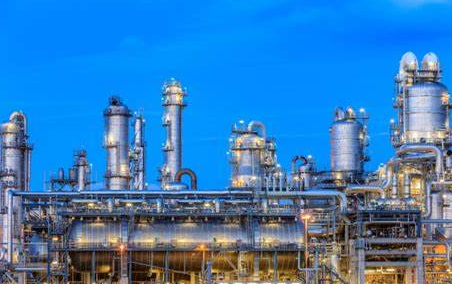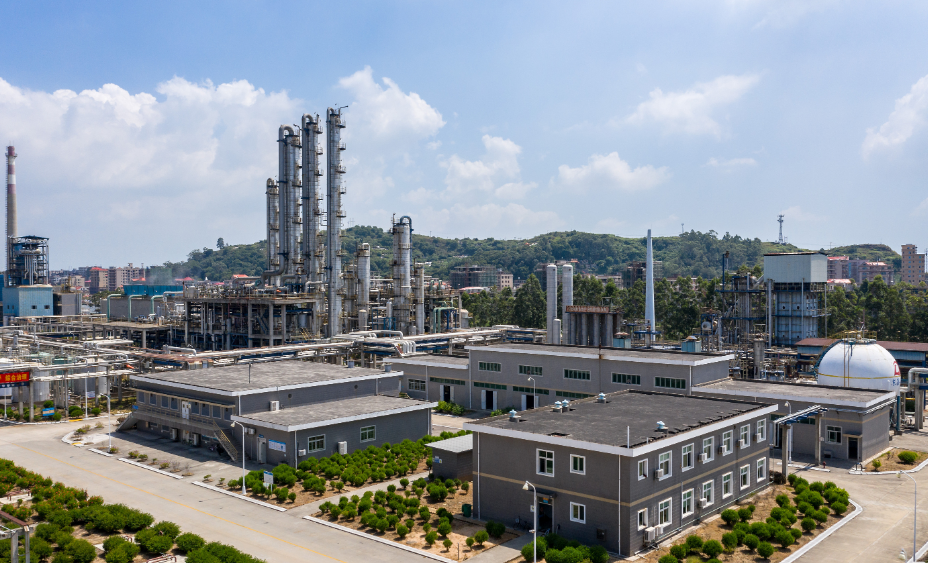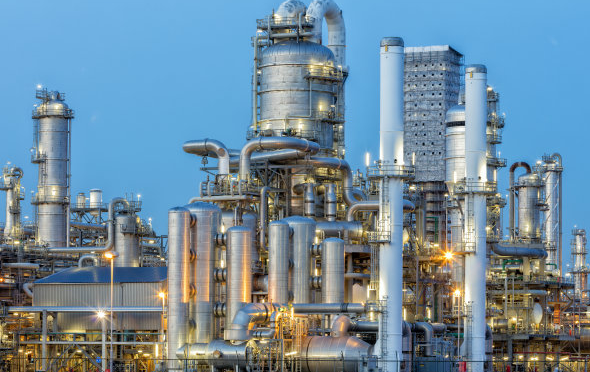Five characteristics and four trends of the development of the global chemical industry
Five features:
(1) Industrial development is cyclical
(2) Diversified sources of raw materials
(3) High-end downstream demand
(4) The development model tends to be large-scale and integrated
(5) Industrial clusters gradually move closer to upstream raw materials and downstream markets
Four major trends:
(1) Industrial structure: accelerated adjustment
(2) Corporate trends: business focus and merger and reorganization
(3) Driving force: innovation-driven and green driven
(4) Digital revolution: Deep integration with information technology

Global industry has five characteristics
1. Industrial development is cyclical
The global chemical industry is a part of the global economic development, and the periodicity of economic development is enveloping the global chemical industry. In recent years, the global economic growth has slowed down, and the chemical industry has gradually slowed down. The development of emerging economies such as China and India has continued to promote the global chemical industry to maintain a certain development trend in the past few years. In the future, these economies will continue to promote the chemical market with a large population base and strong domestic demand growth momentum. In addition to the impact of the geopolitical characteristics of the Middle East, the shale gas industry in the United States in developed countries has become the biggest variable in recent years, driving the strong development of the American chemical industry.
2. Diversified sources of raw materials
The global chemical landscape is constantly evolving, both on the supply side and on the demand side. At present, petrochemical industry is still the leading industry of modern chemical industry. However, with the continuous breakthrough of key technologies, the alternative route of coal and biomass resources as raw materials has gradually become competitive with oil raw materials in cost, and at the same time, American shale gas (oil) has impacted the global petrochemical production system, and has also had an important impact on the international chemical industry pattern. The diversification of raw materials in chemical industry has become the development status of chemical industry.

3 High-end downstream demand
Major downstream industries such as energy, transportation, construction, medicine, and information industry have put forward more requirements for new products, new performance, and new applications for the chemical industry, and the energy, information, and transportation industries have combined and penetrated with the chemical industry, promoting the improvement of the process, equipment, integration and intelligence level of the chemical industry. At the same time, the real living standard and the future demand for further improvement of the quality of life will bring more diversified and higher quality new development direction to chemical products. These will promote the global chemical industry to continue to move forward.
4. The development model tends to be large-scale and integrated
After several years of great changes, large-scale mergers and acquisitions in the global chemical industry cooled down. In the world, there has been a giant competitive pattern of integrated petroleum and petrochemical companies represented by ExxonMobil, specialized chemical companies represented by BASF, and three types of multinational group companies that have shifted from basic chemicals to modern biotechnology chemicals, such as Kedihua and Bayer (including Monsanto). These companies have occupied absolute competitive advantages in the corresponding fields. In the future, the scale of mergers and acquisitions or divestitures will be reduced but will not stop, and the cumulative number of professional transformation cases will gradually increase. At the same time, with the continuous progress of process technology, engineering technology and equipment manufacturing technology, the global petrochemical equipment has accelerated to large-scale and large-scale development. In addition, the refining and chemical integration technology is becoming more and more mature, the industrial chain continues to extend, and the construction of the base has become inevitable, and the chemical park has become the main mode of industrial development.

5. Industrial clusters gradually move closer to upstream raw materials and downstream markets
Western developed countries retain the development of high-tech chemical industry, and the production of energy-intensive and labor-intensive bulk chemical products has gradually transferred from Western Europe and North America to the Asia-Pacific, Latin America, the Middle East and Eastern Europe, and the proportion of North America and Western Europe in the world petrochemical market has gradually declined. The Middle East (including the Gulf states and Iran) is one of the fastest growing regions in the chemical industry in recent years, the Middle East in the rapid expansion of capacity, but also began to extend the development of downstream petrochemical products. In recent years, the large amount of shale gas exploitation in North America has made ethylene downstream products in North America have obvious price advantages, leading many petrochemical companies to return to the United States.
In addition, due to the huge attraction of the downstream markets in India and China, BASF and other companies actively set up sites in India and China to produce upstream raw materials on the spot to supply the local market. Other reasons for chemical giants to speed up close to raw materials and consumption places are that developed economies have weakened support for global integration, and due to the rapid development of chemical technology in emerging economies, the high technical barriers of giants have been difficult to ensure normal profits, must be further in reducing costs, and pay more attention to product market speed when choosing production bases.

Future development presents new trends
1. Industrial structure: Acceleration of adjustment
The complete oil and chemical industry chain, from the beginning of raw materials to the end of the market can be broadly divided into five industrial structure levels:
● The first level is the oil, gas and chemical mining industry;
● The second level is the basic petrochemical industry (olefins, aromatics and triacids and bases, etc.);
The third level is for the general chemical industry (polymers and synthetic fibers, etc.);
● The fourth level is high-end chemical industry (chemical new energy, chemical new materials, high-tech fine chemicals and modern coal chemical industry, etc.);
Level 5 is for emerging edge and cross-cutting industries in chemical industry (life sciences such as genetic engineering and bioengineering, as well as pharmaceutical and environmental engineering, etc.). Level 5 represents the future direction of the chemical industry and the leading exploration of new technologies.
With the gradual maturity of the developed countries' markets and the progress of industrial technology, the world chemical industry is undergoing a new round of industrial structure adjustment and transformation and upgrading, accelerating the improvement of independent innovation capabilities, and constantly improving the level of industrial structure.
On the one hand, the concentration of resource-oriented industries continues to increase, such as energy, biomass, chemical ore conversion, etc.

On the other hand, the customer-oriented segment is becoming more refined and differentiated in terms of product categories, such as new functional materials, electronic chemicals, membrane materials, nanomaterials and catalysts.
International multinational chemical enterprises have never interrupted the adjustment of industrial structure. As in the 1970s, large-scale adjustment to the fine chemical industry, and since the beginning of this century, the pace of industrial structure adjustment of countries in the world, especially petrochemical powers and famous multinational companies has accelerated significantly, and the investment in the fourth and fifth levels of the industry is increasing, and the competition to seize the commanding heights of the future industry technology is becoming more and more fierce. According to the development trends of resources, energy, population, health, and the environment, foreign chemical giants are accelerating the transfer to materials science, life science, and environmental science industries under the promotion of the government.
Regional and feedstock competition has intensified with regional differentiation in raw materials such as natural gas, liquefied natural gas, naphtha and coal. Due to fluctuating raw material prices, the competitiveness of each region is in flux. Global oil and gas supply and demand have reversed, showing a trend of shifting the focus of consumption to the east and the focus of production to the west. In this context, countries have implemented the diversification strategy of petrochemical raw materials, which has led to the intensification of the development of the chemical industry in major regions of the world. Asia has become the main driving force and largest growth point for new capacity and demand in the global petrochemical industry.

2. Corporate Trends: Business focus and merger and reorganization
Multinational chemical enterprises continue to integrate and optimize their business, gradually withdraw from the traditional chemical industry with low added value and high pollution, give up non-core business in order to improve competitiveness, develop in a more specialized direction, and further strengthen their dominant position in a certain field, such as fine and specialized chemicals or new fields of biotechnology-based life sciences such as pharmaceuticals, health care and agriculture.
In order to strengthen business focus, merger and reorganization between enterprises will always be one of the important development strategies of multinational companies. Companies in developed countries will stop or reduce domestic chemical production and turn to resource countries or regions with market development potential. Some companies in emerging economies will move in the opposite direction, seeking more overseas growth opportunities and seeking acquisitions in developed countries. In the context of weakened support for global integration in advanced economies, the overseas development path of emerging economies is particularly important for companies in these regions.
3 Driving force: Innovation-driven and green driven

Scientific and technological innovation is the most important driving force for industrial development and is also the core competitiveness. In the future, the chemical industry pays more attention to scientific and technological innovation, and actively innovates and develops a new generation of chemical technology. In addition to the inherent pursuit of low consumption, zero emissions, and flexible raw materials, chemical science and technology innovation in the next 10 years will focus on the progress of interdisciplinary and marginal disciplines:
Combining chemistry with biology to promote the development and utilization of medical, agricultural and renewable resources;
● Catalysis, separation and information technology-related chemical reactions and process strengthening technologies;
● Nanoscience, optics, electricity and superimposed new material science and technology;
● Material chemistry combines mechanical processing and chemistry to solve problems, and additive manufacturing uses chemistry to solve mechanical problems.
The high-end and differentiated development of products has become an important trend. The emergence of new products is becoming more and more difficult, and more and more enterprises in developed economies focus on research and development to extend the function of existing products or use them together. Functional chemicals represented by new chemical materials and special chemicals have undergone rapid development. In packaging materials, automotive lightweight, electronic chemicals, building materials, new energy and other fields to form a large number of high-end and functional chemicals portfolio. Now this trend will gradually be passed on to developing emerging economies, creating higher value and more market opportunities.
Product innovation is important, but the combination of product portfolio and service solutions is still the model to achieve the highest profit margin. Most of the leading multinational chemical companies in the concept of innovative development and restructuring, the pursuit of upper and lower priorities (cost advantages and technological advantages) :

● Commanding heights of raw material utilization technology
Such as methane to ethylene technology, artificial light synthesis technology, carbon recycling technology. In addition, the technology of ethane dehydrogenation, propane dehydrogenation, isobutane dehydrogenation to produce isobutene, and n-butane dehydrogenation to produce n-butene is also maturing.
● End market demand
One level is to provide high quality products and package solutions for industrial users, extend the industrial chain, improve enterprise efficiency, and enhance market competitiveness; The other level is to focus on human life itself, putting the focus and commanding heights of innovation and development in medical, health care and life sciences.
The global chemical industry is also striving to change from "end-management" to "whole-process production control" to achieve green, low-carbon and circular development. At the same time for energy saving and emission reduction, environmental protection to provide advanced solutions and technical products, whether it is the traditional "three wastes" treatment and improve the efficiency of energy and resources use, or reduce and control greenhouse gas emissions, the chemical industry will have a great deal to do.
In general, the focus of innovation and development of multinational companies in the next 10 years is at the high-end of the industry's technological structure, closely focusing on life sciences, new chemical materials, new chemical energy, special chemicals and environmental protection technology, accelerating original innovation and characteristic innovation, striving to achieve new breakthroughs in industrial technology, and striving to create new advantages to occupy the future competitive heights.

4 Digital revolution: Deep integration with information technology
Chemical industry has been integrated with biological industry, environmental industry, service industry and financial industry for a long time, and the new trend is to further integrate with the information industry. Chemical professional e-commerce, chemical industry Internet, industrial Internet is gradually advancing and deepening. Chemical enterprises in ERP, MES and other systems integration implementation and application, the integration of chemical industry and the Internet has gradually evolved from online and data to intelligent.
From the "Industry 4.0" and "re-industrialization" strategies proposed by developed countries in Europe and the United States, to the "Internet +" and "Made in China 2025" vigorously promoted by China, chemical companies are reshaping the industrial chain with the deep application of the Internet and information technology. Industry consensus believes that in the face of the baptism of the new round of industrial revolution at home and abroad and the status quo and trend of information construction of domestic enterprises, the chemical industry to create "four-chain integration" (production and finance value chain, industrial value chain, ecological value chain, enterprise manufacturing value chain), technology integration, data integration, security integration and innovation integration as the characteristics of the smart enterprise has become an inevitable direction.
In essence, digitalization is part of the innovation drive, but its importance lies in the fact that the field of digitalization will replace product innovation and solutions as the main battlefield for chemical companies in the next stage of competition, and leading chemical companies such as BASF are actively embracing the digital wave as a top-level strategy. Digitalization not only reduces costs and increases efficiency, but also new business models, technology development models, and organizational models are emerging.

The general trend of the development of the international petrochemical and chemical industry is:
• Crude oil prices remain lower
• The industrial center of gravity has shifted across regional restrictions and increased differentiation
• Accelerate the adjustment of industrial structure and diversify the structure of raw materials
• Innovative development, including digitalization, is the most important driver
• Product differentiation and specialization become important trends
• Energy conservation and environmental protection are important themes for future development
• Industry consolidation and mergers to enhance their competitiveness
- EMERSON
- Honeywell
- CTI
- Rolls-Royce
- General Electric
- Woodward
- Yaskawa
- xYCOM
- Motorola
- Siemens
- Rockwell
- ABB
- B&R
- HIMA
- Construction site
- electricity
- Automobile market
- PLC
- DCS
- Motor drivers
- VSD
- Implications
- cement
- CO2
- CEM
- methane
- Artificial intelligence
- Titanic
- Solar energy
- Hydrogen fuel cell
- Hydrogen and fuel cells
- Hydrogen and oxygen fuel cells
- tyre
- Chemical fiber
- dynamo
- corpuscle
- Pulp and paper
- printing
- fossil
- FANUC
- Food and beverage
- Life science
- Sewage treatment
- Personal care
- electricity
- boats
- infrastructure
- Automobile industry
- metallurgy
- Nuclear power generation
- Geothermal power generation
- Water and wastewater
- Infrastructure construction
- Mine hazard
- steel
- papermaking
- Natural gas industry
- Infrastructure construction
- Power and energy
- Rubber and plastic
- Renewable energy
- pharmacy
- mining
- Plastic industry
- Schneider
- Kongsberg
- NI
- Wind energy
- International petroleum
- International new energy network
- gas
- WATLOW
- ProSoft
- SEW
- wind
- ADVANCED
- Reliance
- YOKOGAWA
- TRICONEX
- FOXBORO
- METSO
- MAN
- Advantest
- ADVANCED
- ALSTOM
- Control Wave
- AB
- AMAT
- STUDER
- KONGSBERG
- MOTOROLA
- DANAHER MOTION
- Bently
- Galil
- EATON
- MOLEX
- Triconex
- DEIF
- B&W
- ZYGO
- Aerotech
- DANFOSS
- KOLLMORGEN
- Beijer
- Endress+Hauser
- MOOG
- KB
- Moxa
- Rexroth


Email:wang@kongjiangauto.com


















































































































